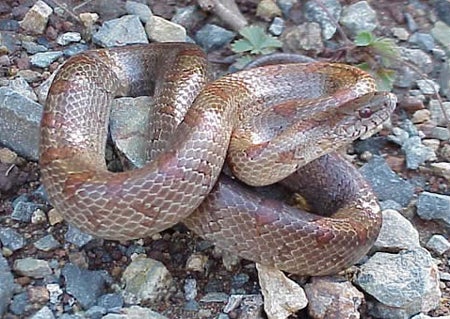SCIENTIFIC NAME:
Lampropeltis calligaster rhombomaculata
STATUS:
Uncommon to rare in Coastal Plain, uncommon elsewhere. Thought to occur statewide, but records are lacking from substantial areas. MODERATE CONSERVATION CONCERN.
DESCRIPTION:
Mole kingsnakes are unlikely to reach lengths greater than 4.5 feet. Its base color is typically light brown, though pink or yellowish hues may be present. Mole kingsnakes have dark brown or reddish, saddle-like blotches along their back; along its side are additional blotches that alternate in spacing with the dorsal pattern. These patterns are striking when individuals are young and spots may appear reddish at this age, however it often fades with age. The belly is noticeably lighter than the rest of the body, and may appear cream-colored. Scales are smooth. The mole kingsnake is mostly likely to be confused with the corn snake, but the anal plate of the latter is divided.
DISTRIBUTION:
The mole kingsnake is a subspecies of the yellow-bellied kingsnake (Lampropeltis calligaster) which ranges throughout much of the southeastern and Midwestern United States. The mole kingsnake has a more restricted range, from Maryland south through the Florida panhandle and west to Tennessee and Louisiana. A rarely encountered and secretive species, it is difficult to accurately delineate its range within Alabama. Mount verified a number of specimens generally from the north-central portion of the state but also identified records around Mobile. His conclusion was that the species could likely be found throughout the state. However, the range of another subspecies, the superficially similar prairie kingsnake (L. c. calligaster) approaches northern Alabama. Not enough specimens have been collected in this area to accurately determine if the ranges of these two snakes overlap.
HABITAT:
If one were to characterize mole kingsnake habitat based on where most individuals are encountered, the temptation would be to conclude they prefer to live on the road. The reality is they are so infrequently observed it’s difficult to ascertain the natural habitats in which occur. For example, an intensive amphibian and reptile trapping effort in Conecuh National Forest did not document a single mole kingsnake, but one was incidentally encountered on the road by the primary investigator while leading a class trip. However, we do know they are a terrestrial snake and spend most of their time underground. Based on what is known about the species elsewhere, it is likely they can be found in fields and open forests. Occasionally are found above ground after dark, especially after rains.
FEEDING HABITS:
Mole kingsnakes likely feed on a wide variety of small mammals, lizards, and other similar-sized prey.
LIFE HISTORY AND ECOLOGY:
Based on what is known about the species, mole kingsnakes likely mate in the spring and females will lay approximately ten eggs in loose or disturbed soils one to two months later. As noted above, the mole kingsnake spends much of its time underground as is rarely observed. Consequently, we know little ecology and natural history specific to the subspecies.
REFERENCES:
Ernst, C. H. and E. M. Ernst. 2003. Snakes of the United States and Canada. Smithsonian Institution Press, Washington, D. C.
Guyer, C., M. A. Bailey, J. Holmes, J. Stiles, and S. Stiles. 2007. Herpetofaunal response to longleaf pine ecosystem restoration, Conecuh National Forest, Alabama. Conecuh NF Final Herp Report April 2007.pdf.
Krysko, K. L. and D. B. Means. 2008. Mole Kingsnake In Amphibians and Reptiles of Georgia. J. B. Jensen, C. D. Camp, W. Gibbons, and M. J. Elliot (eds.). University of Georgia Press, Athens GA.
Mount, R. 1975. The Reptiles & Amphibians of Alabama. Auburn Printing Co., Auburn, AL. 347 pp.
AUTHOR:
David A. Steen, Ph.D. Candidate, Auburn University






